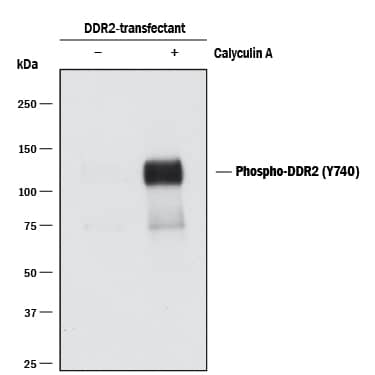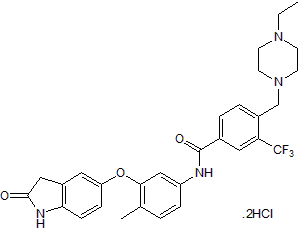DDR1 Products
DDR1, also known as CAK, CD167a, RTK6, and TrkE, is a 120-140 kDa type I transmembrane glycoprotein that belongs to the discoidin-like domain containing subfamily of receptor tyrosine kinases and serve as receptors for collagen. DDR1 is expressed on epithelial tissues, activated monocytes and neutrophils, and in several cancers. Compared to isoform DDR1b, DDR1a lacks 37 aa’s that include a Shc-interacting NPxY motif in the cytoplasmic juxtamembrane region. Two additional kinase deficient splice forms are expressed in colon cancer. The discoidin-like domain mediates binding to collagens I-V. DDR1 selectively recognizes the triple helical structure of collagen. It is expressed on the cell surface as a dimer which can include different isoforms. DDR1 oligomerization enhances collagen binding and also modulates collagen fibrillogenesis. The transmembrane segment contains a leucine zipper and GxxxG motif, but neither is exclusively required for dimerization. Collagen binding induces prolonged autophosphorylation, including the NPxY motif. Collagen binding also results in the proteolytic cleavage of a tyrosine phosphorylated 60 kDa C-terminal fragment (CTF), and a 60 kDa ECD fragment. TIMP-3 and TAPI-1 inhibit shedding of the ECD fragment but not the CTF. Overexpression of DDR1a promotes MMP-2 activation and results in an increased invasiveness of a glioblastoma cell line; DDR1b does not.
79 results for "DDR1" in Products
79 results for "DDR1" in Products
DDR1 Products
DDR1, also known as CAK, CD167a, RTK6, and TrkE, is a 120-140 kDa type I transmembrane glycoprotein that belongs to the discoidin-like domain containing subfamily of receptor tyrosine kinases and serve as receptors for collagen. DDR1 is expressed on epithelial tissues, activated monocytes and neutrophils, and in several cancers. Compared to isoform DDR1b, DDR1a lacks 37 aa’s that include a Shc-interacting NPxY motif in the cytoplasmic juxtamembrane region. Two additional kinase deficient splice forms are expressed in colon cancer. The discoidin-like domain mediates binding to collagens I-V. DDR1 selectively recognizes the triple helical structure of collagen. It is expressed on the cell surface as a dimer which can include different isoforms. DDR1 oligomerization enhances collagen binding and also modulates collagen fibrillogenesis. The transmembrane segment contains a leucine zipper and GxxxG motif, but neither is exclusively required for dimerization. Collagen binding induces prolonged autophosphorylation, including the NPxY motif. Collagen binding also results in the proteolytic cleavage of a tyrosine phosphorylated 60 kDa C-terminal fragment (CTF), and a 60 kDa ECD fragment. TIMP-3 and TAPI-1 inhibit shedding of the ECD fragment but not the CTF. Overexpression of DDR1a promotes MMP-2 activation and results in an increased invasiveness of a glioblastoma cell line; DDR1b does not.
Recombinant Monoclonal Antibody.
| Reactivity: | Human |
| Details: | Rabbit IgG Monoclonal Clone #1119D |
| Applications: | WB, Simple Western |
Recombinant Monoclonal Antibody
| Reactivity: | Human |
| Details: | Mouse IgG1 Monoclonal Clone #Imperial College anti-DDR1 |
| Applications: | ELISA, Flow, Func |
Recombinant Monoclonal Antibody
| Reactivity: | Human |
| Details: | Mouse IgG1 Monoclonal Clone #Imperial College anti-DDR1 |
| Applications: | ELISA, Flow, Func |
Recombinant Monoclonal Antibody
| Reactivity: | Human |
| Details: | Mouse IgG1 Monoclonal Clone #Imperial College anti-DDR1 |
| Applications: | ELISA, Flow, Func |
| Reactivity: | Human |
| Details: | Goat IgG Polyclonal |
| Applications: | WB, Simple Western, IHC |
Selective DDR1 inhibitor
| Chemical Name: | N-[3-[(2,3-Dihydro-2-oxo-1H-indol-5-yl)oxy]-4-methylphenyl]-4-[(4-ethyl-1-piperazinyl)methyl]-3-(trifluoromethyl)benzamide dihydrochloride |
| Purity: | ≥98% (HPLC) |
| Reactivity: | Human |
| Details: | Mouse IgG2a Monoclonal Clone #290420 |
| Applications: | IP |
| Source: | NS0 |
| Accession #: | Q5ST11 |
| Applications: | Bind |
| Reactivity: | Human |
| Details: | Goat IgG Polyclonal |
| Applications: | WB |
| Reactivity: | Human, Mouse |
| Details: | Rabbit IgG Polyclonal |
| Applications: | IHC, WB |
| Assay Range: | 312.5 - 20,000 pg/mL |
| Applications: | ELISA |
| Source: | NS0 |
| Accession #: | Q03146 |
| Applications: | BA |
| Applications: | ELISA |
| Reactivity: | Human, Canine, Monkey, Bovine, Primate, +3 More |
| Details: | Rabbit IgG Polyclonal |
| Applications: | IHC |
| Applications: | WB |
| Reactivity: | Human |
| Details: | Rabbit IgG Polyclonal |
| Applications: | IHC, WB |
| Applications: | WB |
| Reactivity: | Human, Monkey, Primate |
| Details: | Rabbit IgG Polyclonal |
| Applications: | IHC |
| Applications: | WB |
Recombinant Monoclonal Antibody
| Reactivity: | Human |
| Details: | Rabbit IgG Monoclonal Clone #203 |
| Applications: | ELISA |
Recombinant Monoclonal Antibody
| Reactivity: | Human |
| Details: | Rabbit IgG Monoclonal Clone #017 |
| Applications: | ELISA |
Recombinant Monoclonal Antibody
| Reactivity: | Human |
| Details: | Rabbit IgG Monoclonal Clone #017 |
| Applications: | ELISA |
Recombinant Monoclonal Antibody
| Reactivity: | Human |
| Details: | Rabbit IgG Kappa Monoclonal Clone #3E3 |
| Applications: | WB, ELISA, B/N |
Recombinant Monoclonal Antibody
| Reactivity: | Human |
| Details: | Rabbit IgG Monoclonal Clone #017 |
| Applications: | ELISA |
Recombinant Monoclonal Antibody
| Reactivity: | Human |
| Details: | Rabbit IgG Monoclonal Clone #203 |
| Applications: | ELISA |








![Western Blot: DDR1 Antibody [NBP1-33134] Western Blot: DDR1 Antibody [NBP1-33134]](https://resources.bio-techne.com/images/products/DDR1-Antibody-Western-Blot-NBP1-33134-img0004.jpg)


![Immunohistochemistry-Paraffin: DDR1 Antibody - BSA Free [NB110-39011] Immunohistochemistry-Paraffin: DDR1 Antibody - BSA Free [NB110-39011]](https://resources.bio-techne.com/images/products/DDR1-Antibody---BSA-Free-Immunohistochemistry-Paraffin-NB110-39011-img0002.jpg)
![Western Blot: DDR1 Overexpression Lysate [NBL1-09777] Western Blot: DDR1 Overexpression Lysate [NBL1-09777]](https://resources.bio-techne.com/images/products/DDR1-Overexpression-Lysate-Adult-Normal-Western-Blot-NBL1-09777-img0002.jpg)
![Western Blot: DDR1 Antibody [NBP2-16123] Western Blot: DDR1 Antibody [NBP2-16123]](https://resources.bio-techne.com/images/products/DDR1-Antibody-Western-Blot-NBP2-16123-img0004.jpg)
![Western Blot: DDR1 Overexpression Lysate [NBP2-09858] Western Blot: DDR1 Overexpression Lysate [NBP2-09858]](https://resources.bio-techne.com/images/products/DDR1-Overexpression-Lysate-Adult-Normal-Western-Blot-NBP2-09858-img0001.jpg)
![Immunohistochemistry-Paraffin: DDR1 Antibody - BSA Free [NB110-39041] Immunohistochemistry-Paraffin: DDR1 Antibody - BSA Free [NB110-39041]](https://resources.bio-techne.com/images/products/DDR1-Antibody---BSA-Free-Immunohistochemistry-Paraffin-NB110-39041-img0001.jpg)
![Western Blot: DDR1 Overexpression Lysate [NBP2-09857] Western Blot: DDR1 Overexpression Lysate [NBP2-09857]](https://resources.bio-techne.com/images/products/DDR1-Overexpression-Lysate-Adult-Normal-Western-Blot-NBP2-09857-img0001.jpg)